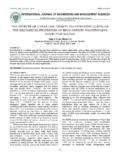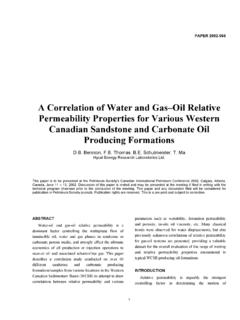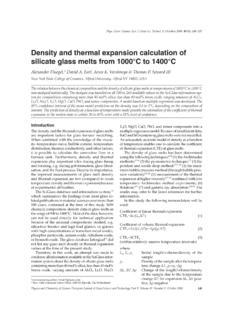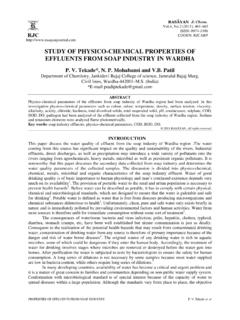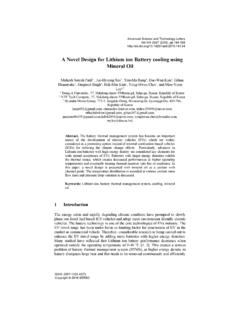Transcription of Prediction of Wax Deposition Risk of Malaysian …
1 International Journal of Science and Advanced Technology (ISSN 2221-8386) Volume 1 No 6 August 2011 89 Prediction of Wax Deposition Risk of Malaysian Crude from Viscosity-Temperature Correlation for Dead Crude Ekeh Modesty Kelechukwu Dept. of petroleum engineering, UCSI University 56000 Cheras, Kuala Lumpur E-mail: Abstract- Malaysian oil production occurs offshore and extreme environment, its cold temperature could make wax Deposition problems almost inevitable as most of the oilfields approaching their matured stage of production. Wax Deposition had demonstrated a critical concern in the quest to increase oil recovery from producing reservoirs. The unwanted effect of wax Deposition could cause reduced productivity, complete plugging of pipeline, minimum profitability and other hazardous risks; while its mitigation operations and production losses are expensive and economically unjustified.
2 This study employed Standing correlation model for the viscosity-temperature relationship of dead crude to predict wax crystallization point. The predicted wax appearance points were in good agreement with the experimental values of the Malaysian dead crude oils, with average absolute deviation (AAD %) of However, the Standing model varied significantly with the measured viscosity data. The main goal of this work was to predict wax Deposition threat or related problems in Malaysian fields. Keywords- Prediction of wax; potential wax problem; Malaysian crude. I. I. Introduction The presence of paraffin waxes in crude oils presents a multitude of problems to the producers. The problems associated with their presence range from minor to severe, and depend on their quantity and composition.
3 Petroleum production can be significantly affected by Deposition of paraffin wax during crude production, with devastating economic consequences. Hence, predicting wax problems within the production tubing and flowlines that could decrease or halt production is essential in optimizing production and operating efficiency. The liquid hydrocarbons initially are in equilibrium in the reservoir under super-saturated temperature-pressure conditions. Paraffin generally consist of straight and branched chain hydrocarbons and precipitates out of waxy crude when there is a slight change in equilibrium conditions, causing a loss of solubility of the wax in the crude. A decrease in temperature is the most common cause of paraffinInternational Journal of Science and Advanced Technology (ISSN 2221-8386) Volume 1 No 6 August 2011 90 wax precipitation, though many other factors could affect the processHowever, the solubility of paraffin waxes is not only sensitive to temperature variation, but also an integration of physiochemical properties of the crude and other operation factors in production system.
4 Thus, accurate knowledge of the nature of any crude oil, as characterized by its physiochemical properties or classification is vital in the quest for solution to production risk or intervention strategy for handling waxy crude. The main goal of this work was to predict wax Deposition threat or related problems in Malaysian fields, using experimental methodology to simulate wax Deposition in the laboratory. II. Wax Deposition Mechanism A problem of paraffin wax may be described as a situation in which a predominantly organic deposit hampers the production of crude oil; the loss crude production from well depends on the severity and location of the Deposition . In a pioneering work, Burger et al, (1981) investigated four wax Deposition mechanisms: the mechanism of paraffin wax Deposition are governed by molecular diffusion of wax molecules; shear dispersion of wax crystallites and Brownian diffusion of wax crystallites.
5 Gravity settling of paraffin crystals in flow line conditions is negligible, because it s dominated by shear dispersion (Burger et al., 1981). Molecular diffusion is the Deposition mechanism prevalent for tubing Deposition in flowing well that maintains oil temperature, well above the cloud point until the oil is coming up the tubing (Bern et al., 1980; Leiroz and Azevedo, 2005). Deposition is enhanced as result of lateral transportation by the. In wax Deposition mechanism process, a concentration gradient is produced in the oil as a result of temperature gradient profile, due to increasing solubility of waxes with increasing temperature. The concentration caused waxes in solution to diffuse from the warmer oil, which has a greater concentration of dissolved waxes, to the colder oil, which has a lower concentration, resulting to molecular diffusion of the paraffin crystals towards the surface wall.
6 III. Reference Crude Oils Characterization Physiochemical properties (API gravity and pour point), density, viscosity, Wax Appearance Temperature as well as Wax content of the five reference crude oils were measured. Table 1 presents results analysis of crude samples from various oil fields in Malaysia, generated at the unipem laboratory of the Universiti Teknologi Malaysia. The crudes varied greatly in their characteristics and composition. They varied in color from black to light brown, and density measured at 15 C, varies from to kg/L, viscosity at 40 C varied between to cSt and at 70 C varies from to cSt. Water content in all the sampled crude were very minimum, (less than 1% vol.).
7 The API Gravity ranges from light oil to heavy crude oil, ( to International Journal of Science and Advanced Technology (ISSN 2221-8386) Volume 1 No 6 August 2011 91 ) respectively, while pour point varies between 18 to 36 C. The result data of the samples understudy showed that Penara contains the highest percentage of wax content followed by Bunga Kekwa and Dulang, while Tapis had the lowest wax percentage. The Wax Appearance Temperature measurements were made following the wax app I method ( / min), and the figure varied from to (values in oC). There was also a clear correlation between high density and low API Gravity, while a qualitative correlation confirmed higher pour point with higher wax content amongst the analyzed samples.
8 Table I: Physiochemical properties of some Malaysian oilfields Table II. Physiochemical properties of some Malaysian oilfields Types of Crude Pour point oC WAT oC Wax content % wt Water content % vol. Angsi 30 0 Bunga Kekwa 36 Dulang 33 Penara 36 Tapis 18 0 IV. Empirical Correlation for Dead Crude Oil. The Deposition tendency of wax from crudes can be predicted using a generalized empirical correlation for crude rheological properties. The assumption that fluid obeys the Arrhenius equation, with exponential dependency of viscosity on temperature was applied by [Elsharkawy et al, 2000] in their study of wax Deposition for Middle East crudes. Viscosity is an important empirical parameter in wax Deposition [Richard S. Fulford, 1975].
9 Yong Bio and Qiang Bai (2005) stated that oil viscosity correlations use oil API gravity and reservoir temperature to estimate dead oil viscosity ( od). Many correlations have developed in petroleum literatures to estimate or determine viscosity and temperature, using empirical correlation in lieu of laboratory data. [Yam and Luo, 1987] investigated the effect of temperature on the rheological properties of Daqing crude oils. Specifically, they correlated apparent viscosity with temperature. However, the correlations for viscosity and temperature were derived specifically for the case of conditions of dead crudes (no gas in solution) and it is often estimated using empirical Types of Crude Density g/cm3 @ 15 oC Viscosity (cSt) @ 40 oC Viscosity (cSt) @70 oC API Gravity Angsi Bunga Kekwa Dulang Penara Tapis International Journal of Science and Advanced Technology (ISSN 2221-8386) Volume 1 No 6 August 2011 92 corrections developed by a number of investigators including Baal (1946), Beggs and Robinson (1975), Standing (1981), Glaso (1985), Khan (1987) and Ahmed (1989).
10 The temperature dependence of viscosity is the phenomenon by which liquid viscosity tends to decrease as its temperature increases, vice versa. Realizing that the viscosity of waxy-crude oil at low temperature is non-Newtonian, and its behavior is governed by changes in temperature. As the temperature decreases, the waxy-crude oil becomes more viscous, hence its viscosity depends on temperature decrease. Therefore, as viscosity increases in cold areas the flow resistance increases and if the temperature becomes low enough, the wax in crude may precipitate and deposit. Consequently, organic Deposition from reservoir oil occurring in a specific flow regime should be identifiable from the characteristic oil viscosity-temperature correlation.

